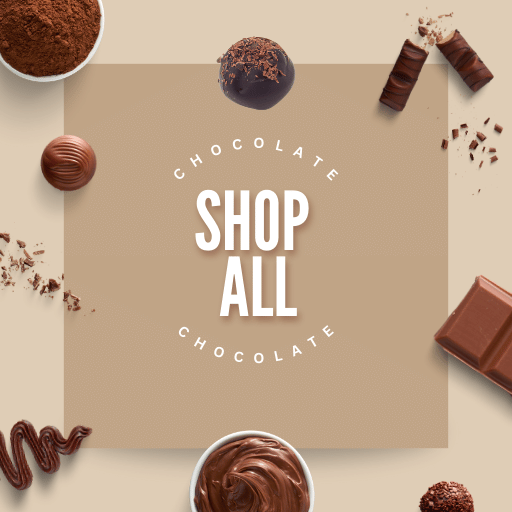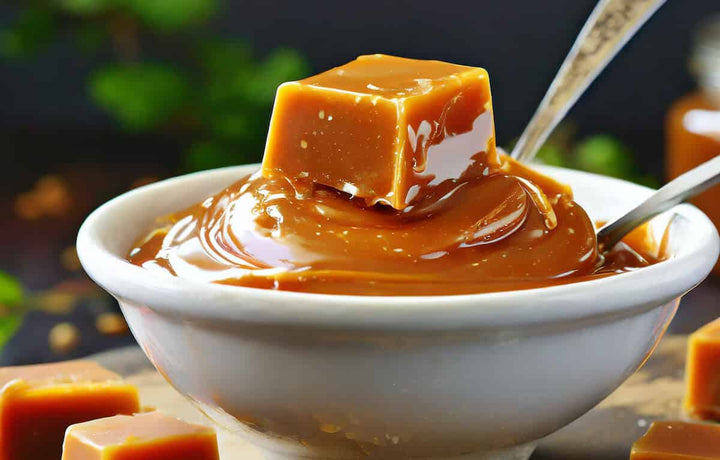Crystallised ginger, also known as candied ginger, is a confection that perfectly balances spicy warmth and sugary sweetness, offering a delightful treat that tantalises the taste buds in more ways than one.
Beyond its role as a standalone snack, crystallised ginger is a versatile culinary component, enhancing everything from baked goods and confectionery to savoury dishes with its unique blend of flavours.
In this post, we will dive into the world of crystallised ginger, exploring its origins, how it's made, and how it can be incorporated into your cooking and baking.
What is Crystallised Ginger?
Crystallised ginger, or candied ginger, is a confection made from fresh ginger root cooked in sugar syrup and then coated with granulated sugar.
This process not only preserves the ginger, extending its shelf life but also transforms it into a sweet treat with a spicy kick.
The ginger first undergoes a slow cooking process in sugar syrup, which softens it and allows it to absorb the sweetness.
Once sufficiently candied, the ginger pieces are rolled in sugar, giving them a sparkly, crystallised appearance and a delightful crunchy texture on the outside while maintaining a soft, chewy interior.
The result is a versatile ingredient that beautifully marries ginger's fiery, pungent flavour with the comforting sweetness of sugar.
Crystallised ginger can be enjoyed as a snack, used as a garnish for desserts and beverages, or incorporated into recipes for baked goods such as cookies, cakes, and bread, where it adds a warm, spicy note.
It is often used in savoury dishes to introduce a sweet and spicy element, demonstrating its wide-ranging appeal in both sweet and savoury culinary contexts.
Related Post: What is Stem Ginger?

How to Make Crystallised Ginger
To make crystallised ginger, peel and thinly slice fresh ginger root.
Boil the slices in water for 20-30 minutes until tender, then drain, reserving 1/2 cup of the cooking water.
Return the ginger and reserved water to the pan, add an equal weight of sugar to the ginger, and stir over low heat until the sugar dissolves.
Simmer until the syrup thickens and the ginger becomes translucent about 20 minutes.
Use a slotted spoon to transfer the ginger to a wire rack, sprinkle with additional sugar, and let cool and dry until firm.
Store the crystallised ginger in an airtight container at room temperature.
Related Post: What is Turkish Delight?
What Can You Substitute Crystallised Ginger With for a Recipe?
If you find yourself without crystallised ginger for a recipe, several substitutes can provide a similar flavour profile or texture.
While the unique sweet and spicy taste of crystallised ginger is somewhat distinct, these alternatives can help you achieve a comparable result in your cooking and baking:
1. Fresh Ginger:
Fresh ginger can be used as a substitute, especially in recipes with insufficient moisture content.
Use 1 tablespoon of freshly grated ginger for every ¼ cup of chopped crystallised ginger.
Remember that fresh ginger will be more potent and less sweet, so you may want to add extra sweetness to the recipe.
2. Ground Ginger:
Ground ginger is another alternative, offering a similar flavour profile without the texture.
Use ⅛ teaspoon of ground ginger for every tablespoon of crystallised ginger called for in the recipe.
Since it's dried and powdered, it might not provide the moisture or chewiness that crystallised ginger would, so it's best used in baked goods.
3. Ginger Powder or Ginger Spice:
Like ground ginger, ginger powder or a ginger spice blend can be used, especially in spice mixes or recipes where ginger is one component of the flavour profile.
The conversion ratio is the same as for ground ginger.
4. Ginger Syrup or Ginger Jam:
If the recipe accommodates additional liquid, ginger syrup or ginger jam can be an excellent substitute for the sweetness and flavour of crystallised ginger.
Use a tablespoon of syrup or jam for every piece of crystallised ginger. Adjust the sugar in your recipe accordingly.
5. Ginger Paste:
Ginger paste, available in tubes or jars, can be used in a pinch.
It combines fresh ginger with oil (and sometimes sugar), offering spice and sweetness. Start with a small amount and adjust to taste, as it can be quite potent.
6. Candied or Dried Fruits:
In recipes where the texture of crystallised ginger is important, other candied or dried fruits, like candied orange peel or dried apricots chopped finely, can provide a similar chewiness, though with a different flavour profile.
Consider adding a bit of ground ginger to these substitutes to mimic the ginger taste.
Adjust the amount of substitute accordingly and consider tweaking other aspects of the recipe (such as sweetness or moisture) to achieve a balanced final product.

What Does Crystallised Ginger Taste Like?
Crystallised ginger offers a unique and captivating taste experience, combining the natural fiery warmth of ginger with a delightful sugary sweetness.
The initial flavour is a bold, spicy kick characteristic of fresh ginger, which quickly melds into a smooth, sweet finish thanks to its sugar coating.
This duality makes crystallised ginger a fascinating ingredient, as it encapsulates the zest and piquancy of ginger while tempering its sharpness with sweetness.
The texture of crystallised ginger adds another layer to its appeal.
It typically has a firm yet chewy exterior from the sugar crystallisation, with a slightly softer, moist interior that melts in the mouth.
This contrast between the crunchy sugar coating and the tender ginger inside makes it not only a pleasure to eat on its own but also a delightful addition to various dishes.
What is the History of Crystallised Ginger?
The history of crystallised ginger, also known as candied ginger, is intertwined with the ancient spice trade and the long-standing human endeavour to preserve food.
Ginger originates from Southeast Asia and has been celebrated for centuries for its culinary and medicinal properties.
Its journey from a regional speciality to a global culinary staple is a testament to its versatility and appeal.
The practice of crystallising ginger likely began in the mediaeval period, if not earlier, as a method to preserve ginger using sugar.
During this time, ginger was a highly prized commodity, transported along the spice routes from Asia to Europe and the Middle East.
As sugar became more widely available in the Middle Ages, particularly in the Arab world and later in Europe, people began experimenting with it as a preservative for fruits, roots, and flowers.
Crystallising ginger in sugar syrup extended its shelf life and transformed it into a sweet treat that could be enjoyed year-round.
This made it particularly popular when fresh produce was not always available, and methods of food preservation were highly valued.
Crystallised ginger was considered a luxury item, often used as a digestive aid, a remedy for nausea, and a flavourful addition to sweets and baked goods.
In the 15th and 16th centuries, as European explorers set sail to discover new lands, ginger was one of the many exotic spices they sought.
The cultivation of ginger spread to the Caribbean and other tropical regions of the New World, where it thrived.
This expansion helped make ginger and, by extension, crystallised ginger more accessible to a broader audience.
By the Victorian era in England, crystallised ginger had become a popular confection, enjoyed on its own or used as an ingredient in cakes, biscuits, and other sweet treats.
Its use spread across the British Empire, influencing culinary traditions in various colonies.
Today, crystallised ginger is appreciated worldwide, not just for its unique flavour and preservative qualities but also for its health benefits.
Where Can You Buy Tasty Chocolate?
Whitakers Chocolates, renowned for our long history in crafting delicious and affordable chocolates, offers a range of options suitable for everyone, including vegetarian, vegan, and gluten-free choices.
Our top-selling products, such as indulgent Coffee Creams, Neapolitans, Chocolate Wafer Thins, Stem Ginger and Luxury Chocolate Truffles, are perfect for enhancing your mocha coffee experience.
Click here to see our full range of delicious chocolates…
Some Notes From an Expert Chocolatier
One of the most rewarding aspects of my craft is exploring and incorporating diverse ingredients into chocolate, creating unique flavour profiles and textures that surprise and delight.
Among these, crystallised ginger holds a special place in my repertoire.
The spicy warmth of ginger, encased in a sweet, sugary shell, contrasts chocolate's rich, smooth depth.
This combination is not just about adding a new flavour to chocolate; it's about creating an experience, a moment of discovery for the palate.
Integrating crystallised ginger into chocolate creations is a careful balance.
The intensity of the ginger must be harmonious with the type of chocolate used, whether it's the boldness of dark chocolate, the creamy richness of milk chocolate, or the delicate sweetness of white chocolate.
Each pairing opens up different dimensions of flavour, from the robust and intense to the subtle and refined.
Final Notes On Crystallised Ginger
Crystallised ginger is a splendid testament to the culinary ingenuity of transforming a simple root into a delectable confection that spans cultures and centuries.
Its unique blend of spicy warmth and sugary sweetness makes it a versatile ingredient that enriches various dishes, from sweet treats to savoury concoctions.
The process of crystallising ginger not only preserves its vibrant flavour but also unlocks new possibilities for its use in the culinary world, allowing chefs and home cooks alike to experiment with its distinctive taste.
It remains a favourite among confectioners and chocolatiers, who cherish its ability to add depth and complexity to their creations, bridging the gap between tradition and innovation.
Whether enjoyed as a standalone snack, used as a garnish, or incorporated into recipes, crystallised ginger invites a moment of indulgence, a spark of warmth that can elevate a simple dish to something truly memorable.











